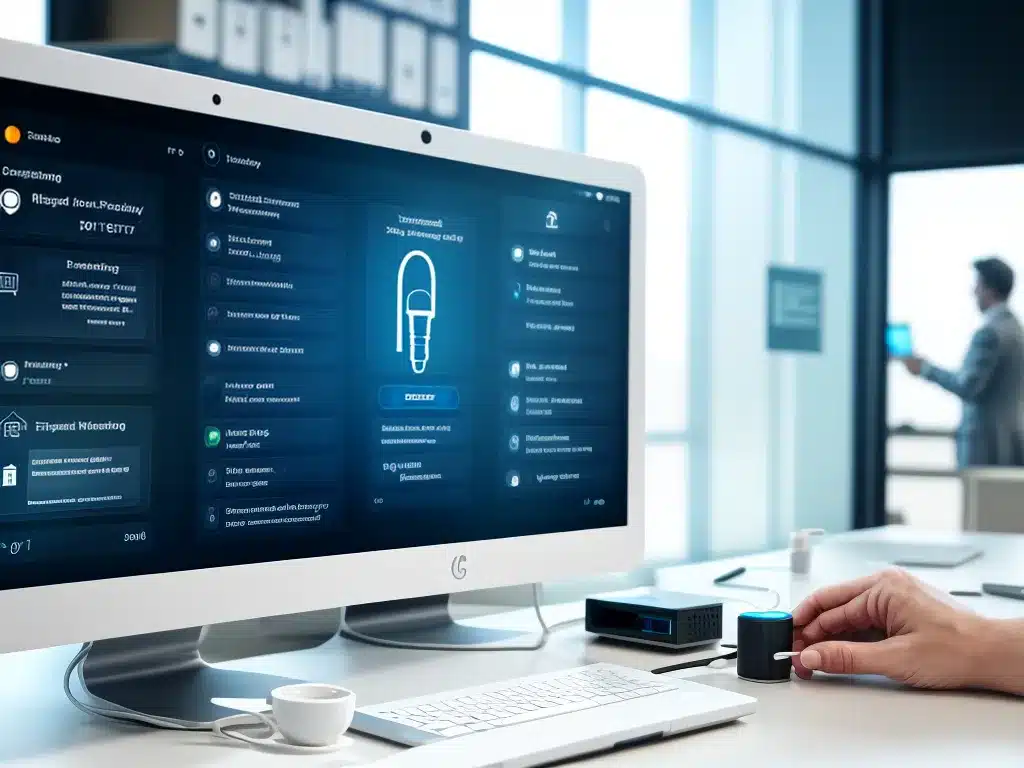
Introduction
The modern workplace is rapidly evolving due to advancements in technology and connectivity. Internet of Things (IoT) devices and smart office solutions are transforming traditional work environments into intelligent workspaces that promote productivity, collaboration, and employee satisfaction. As a business leader, understanding how to strategically implement IoT and smart technology in the office is key to boosting performance. In this article, I will discuss:
How IoT Enables Smart Office Capabilities
The Internet of Things refers to the growing network of internet-connected objects and devices that can collect and share data. IoT devices feature built-in sensors, software, and connectivity that allow them to communicate real-time data and be controlled remotely.
Here are some of the most common IoT applications in smart offices:
Lighting Control
Smart lighting solutions adjust illumination automatically based on occupancy and natural light. IoT lighting systems can be controlled via mobile apps and respond to data from networked motion sensors. Benefits include:
- Optimized lighting for visual comfort and productivity
- Energy savings from reduced electricity use
HVAC Monitoring
IoT-enabled HVAC systems utilize wireless sensors that track temperature, humidity, air quality, and occupancy. The collected data allows HVAC units to adjust dynamically to maintain optimal conditions. Benefits include:
- Increased energy efficiency
- Proactive identification of required maintenance
- Temperature customized to different zones
Access Control
IoT-connected access control systems include features like smart locks, IP cameras, and occupancy management. They boost security while also enabling remote control and automation.
Asset Tracking
Asset tracking IoT solutions use tags, beacons, RFID, and other sensors to provide real-time visibility into equipment and inventory location. Benefits include:
- Reduced time spent searching for assets
- Streamlined equipment check-in/check-out
- Loss prevention and theft deterrence
Key Benefits of a Connected Smart Office
Implementing IoT devices and software to create a connected smart office environment provides well-documented benefits for businesses across industries. The key perks include:
Enhanced productivity
By automating mundane tasks and optimizing workspace conditions to keep employees comfortable and focused, smart offices foster more productive work.
Improved safety and security
IoT-enabled access control, 24/7 monitoring, and asset tracking promotes a more secure work environment.
Cost savings
Between energy optimization and streamlining of tasks, smart offices can significantly reduce overhead costs. McKinsey estimates IoT applications in offices can lower operating costs by 10-20%.
Flexibility and scalability
IoT infrastructure can be easily adapted to changing needs as a business grows or layouts change. Software and analytics also provide metrics to inform future optimization.
Sustainability
Smart lighting, HVAC, and other systems dramatically improve energy efficiency and reduce a building’s carbon footprint.
Challenges of Smart Office Integration
While promising, integrating a full range of IoT tech requires overcoming some hurdles:
Upfront costs
The upfront investment in sensors, software, analytic tools, and infrastructure upgrades can have a high initial price tag. ROI is achieved over a longer time period.
Interoperability issues
With so many devices and platforms, lack of common standards can hinder IoT integration and data sharing between different applications.
Data security concerns
Any connected system comes with cybersecurity risks that must be addressed through robust access controls, encryption, and personnel training.
Technical complexity
Installing and managing an array of sensors, devices, and dashboards requires hiring staff with the right IoT skillsets and capabilities.
Best Practices for Implementation
Follow these best practices when rolling out an IoT-enabled smart office:
Start with a needs assessment – Review pain points, goals, and use cases before investing in technology. Prioritize solutions that maximize impact and ROI.
Take an incremental approach – It’s not feasible to overhaul everything at once. Start with a pilot focused on a single key area before expanding.
Choose solutions using open standards – This improves interoperability between devices and platforms.
Automate for agility – Utilize APIs and rules engines to reduce manual control. automate actions based on sensor data.
Embed security from the start – Build in safeguards across hardware, communications, data storage, and access.
Provide training – Employees will interact with new systems. Give proper instruction so solutions are utilized effectively.
Collect and analyze data – Leverage analytics tools to gain visibility into usage patterns and opportunities for further optimization.
The Future of the Smart Office
IoT and smart office technology will continue advancing rapidly. Some emerging innovations include:
-
Predictive analytics – Platforms utilizing artificial intelligence that forecast usage trends and detect potential issues proactively.
-
Digital twins – Virtual models of workspaces that inform simulations and test scenarios for upgrades.
-
Augmented reality – AR overlays in office environments that display contextual information and guidance.
-
Workplace experience apps – Integrated platforms with capabilities ranging from wayfinding to controlling systems via mobile devices.
By harnessing these innovations and best practices, any organization can begin creating an intelligent workplace that supercharges productivity. The smart office enabled by IoT represents the future of how we will work.












